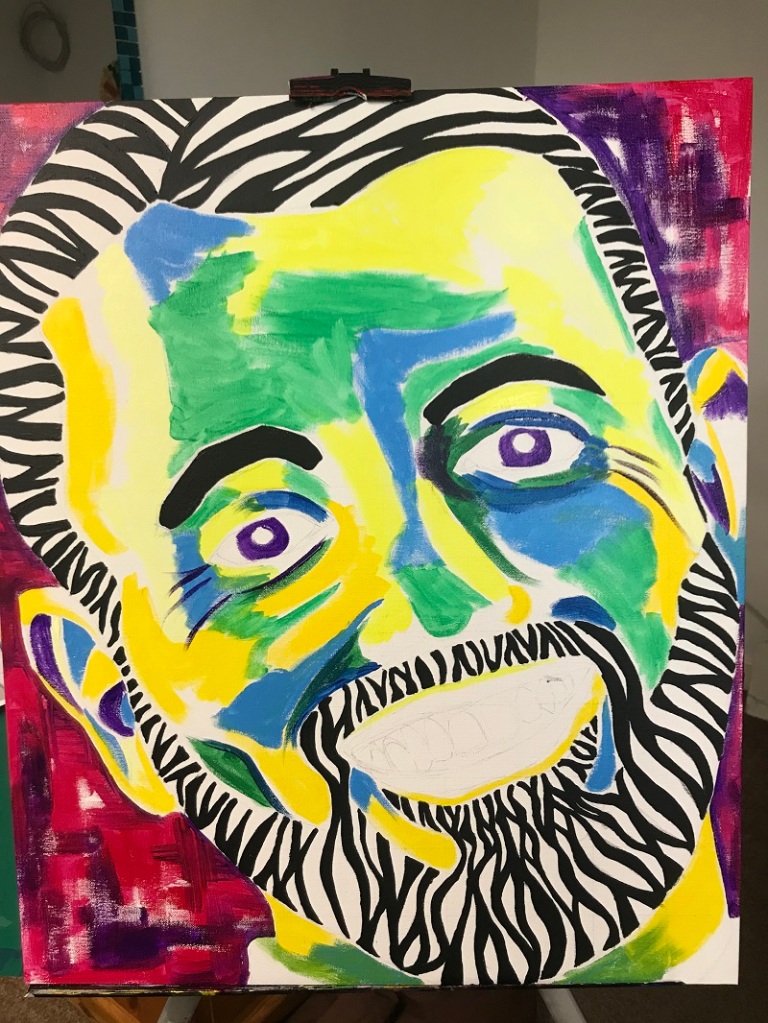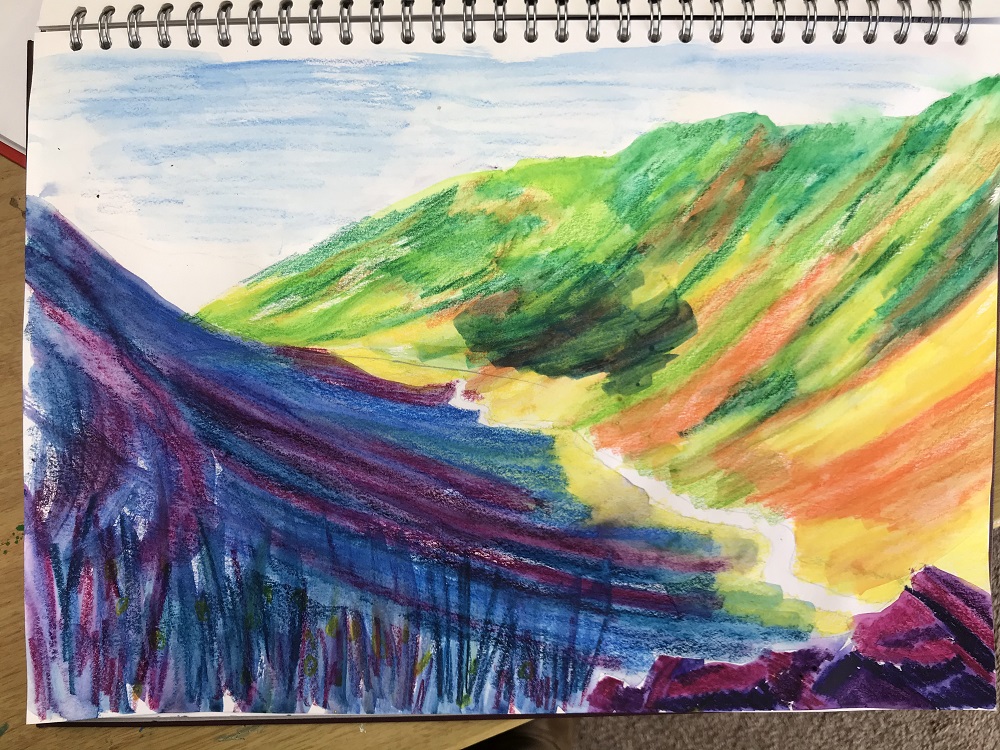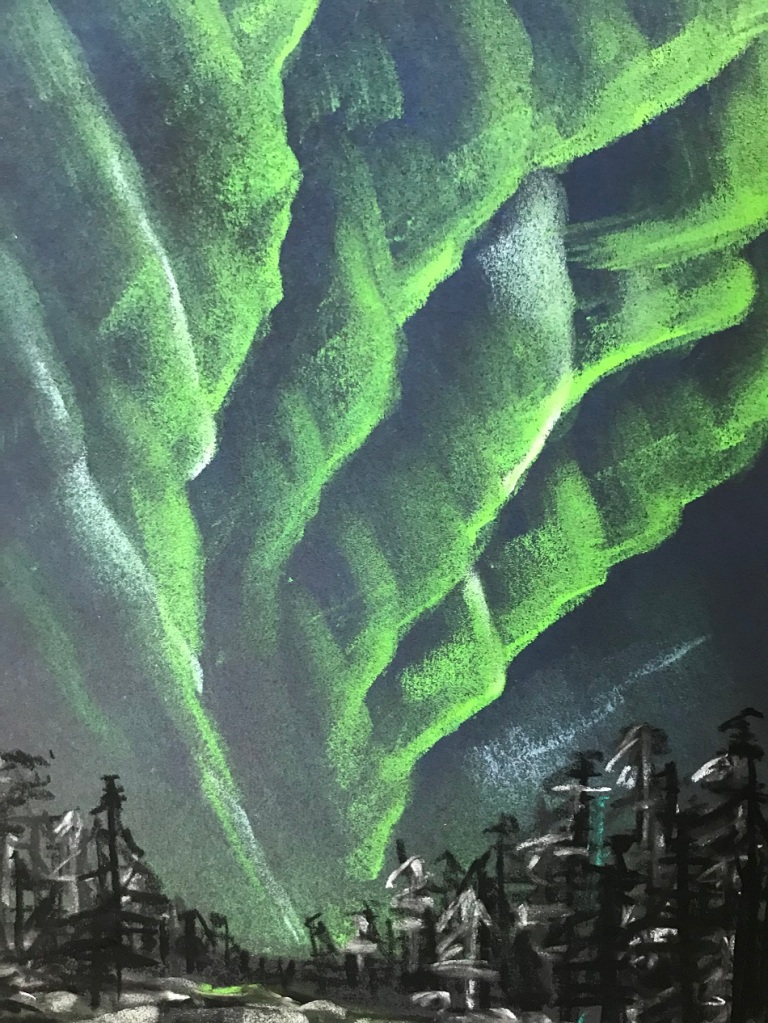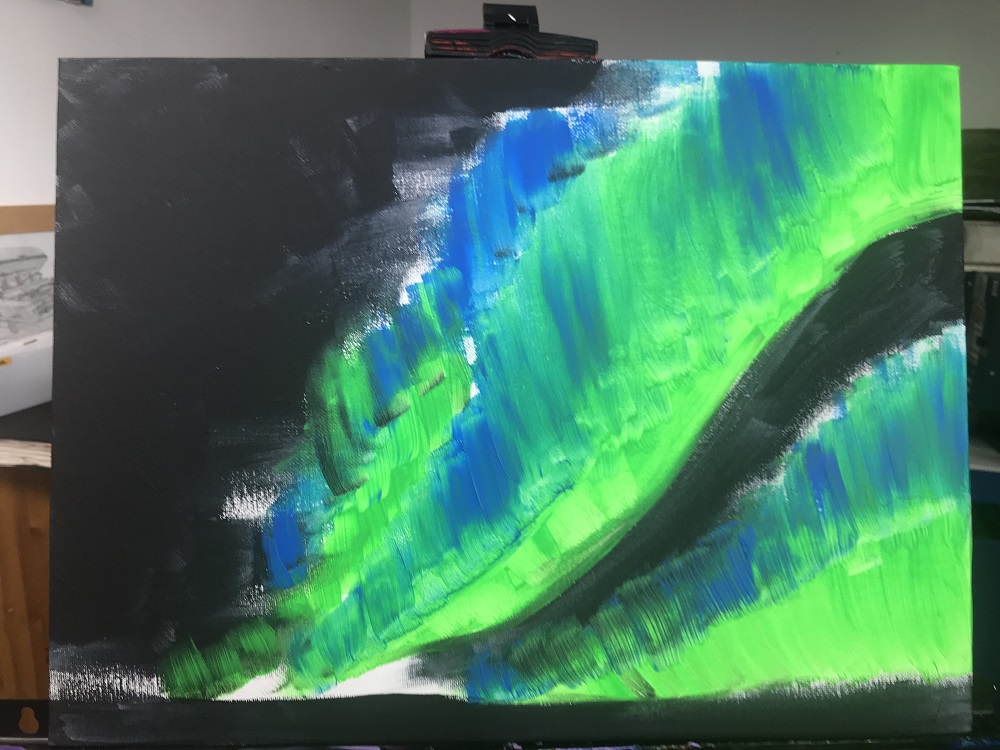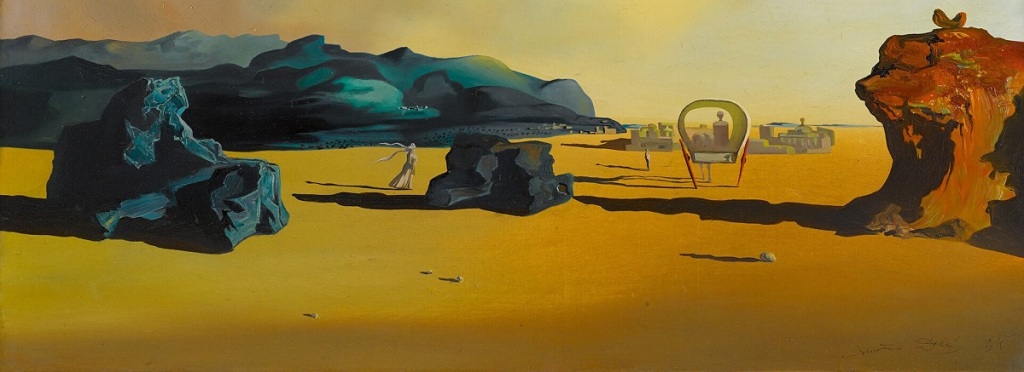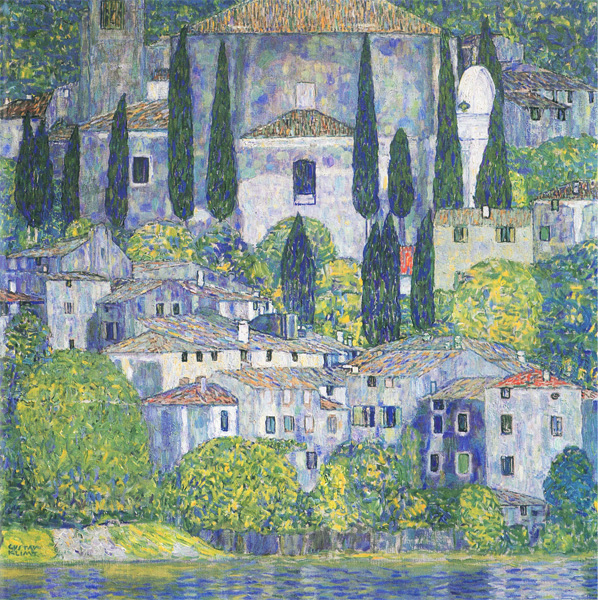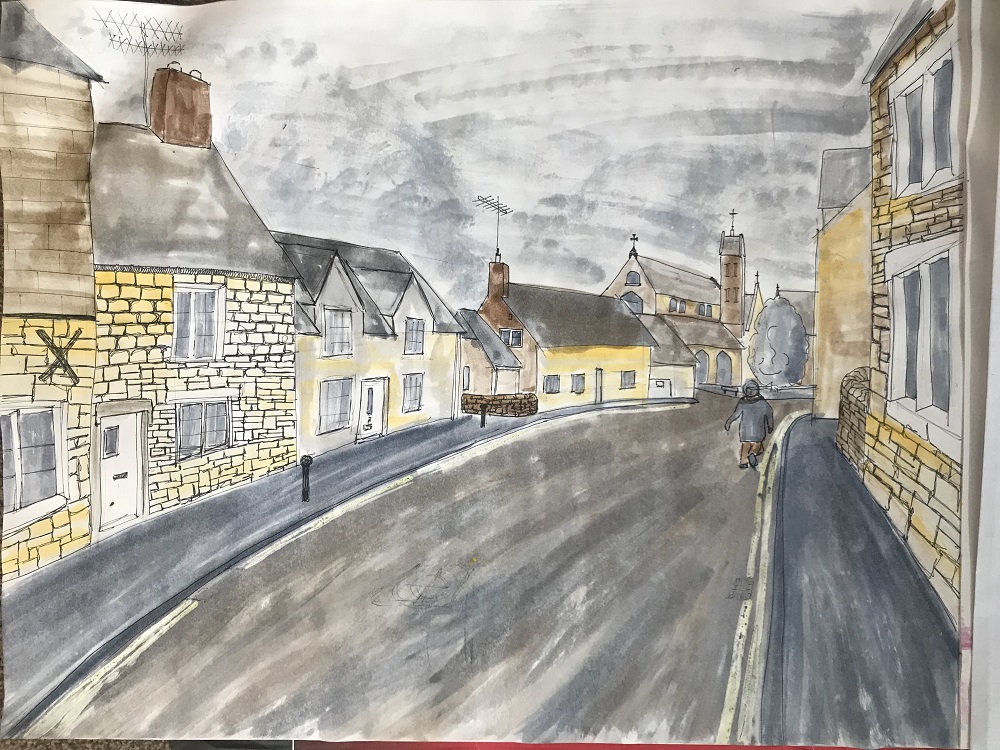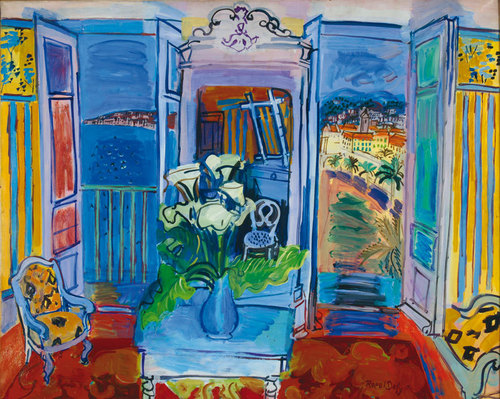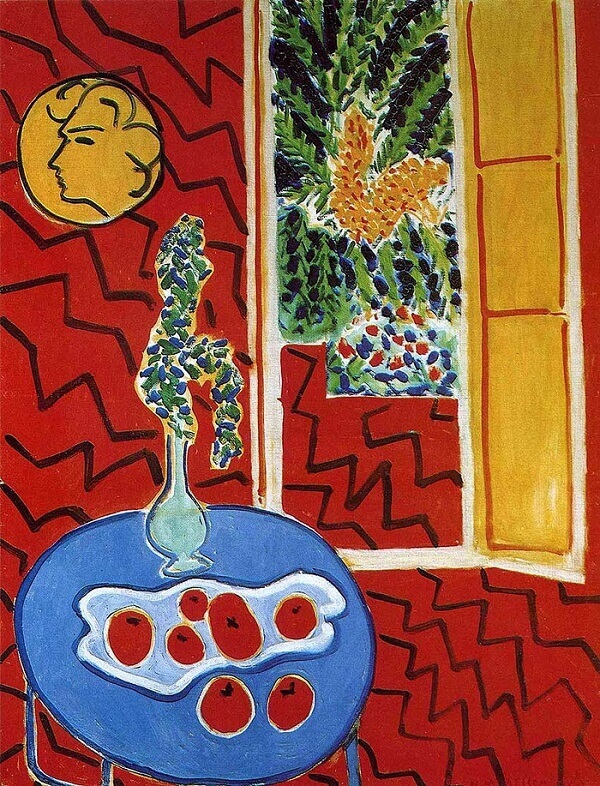Exercise: Painting from a working drawing
‘a corner of a room or objects on a table by a window’… not feeling inspired by this at all, I’m in the landscape mode and going back to still life and interiors has stumped me rather.

a linear study

a colour study

a tonal study
Exercise: Squaring up
This is a method I have used before for the portraits in assignment 3. I had one final portrait left to do of my son Tom but didn’t include that with the assignment since it needed a lot of thought to adapt my style for a male. I have since been working on this and rather than start a totally new squaring up landscape painting, I am going to finish this portrait off instead.
Started with some trial sketches – see sketchbook

Trying to get the right pose and the grid correct 
This one, with grid at angle so that his face isn’t square on to viewer

Coloured sketch… 
then cropped – better
This sketch worked best I feel. Using black lines again for the hair as before with the girls, but this time it’s not flowing and loose. Using different width and shaped lines to give impression of hairs and style.
Deciding which colours to use so that it’s vibrant and blends in with the other two portraits whilst still being different from them.
- Background needs to be less red and more blue/purple to blend better with palette of skin.
- Keep a little red within skin so lips work but the red beneath eyes is not working at moment.
- Adjust top line of upper lip which doesn’t match nose line at present
- White highlights
The squaring up method really works for me with portraits as it gives me the confidence that everything is in the correct place so I can just focus on getting the tones correct. Whether this would be necessary with a landscape or not remains to be seen. My type of landscape wouldn’t need to be totally accurate, in fact it would probably be better having certain parts exaggerated and others reduced/left out.
Exercise: Working from a photograph
It’s the first decent day today for weeks so I pushed myself to walk up Brentor on Dartmoor to do some sketches of the surrounding valleys – see sketchbook.
This one I quite liked and decided to use it, and the photos taken, for this painting. Tried out several crops:
Large canvas board, 30x20inch, acrylics
Started off with rough coverage of canvas but feeling totally uninspired by it so changed to impasto using palette knives.

crop of bottom right 
crop of sky
A little better but it’s still not going in the right direction. Foreground tree line is beginning to come together – I like the rough texture which brings it forward. Fields are all too green with orangey moorland behind – there is no connection between the two. I think it’s just the wrong composition and nothing is going to make the painting hang together well. There is nothing to take the eye around – no diagonal or features to focus on. Time to give this up and do some research as to what exactly I’m hoping to achieve!
Lorna Holdcroft-Kirin:
I discovered this Sussex artist whilst looking through my books for inspiration. Acrylics on canvas.

Broadstone 
Ditchling Beacon 
Friends Clump 
Landscape 
Sussex Weald III 
Truleigh Hill 
Towards Glynde
Love this last one especially: vibrant yet still realistic colours, some fields lite up by the sun coming through clouds, texture and mark making in the foreground bring that part forward whilst the smoother distant hills are pushed back. Partly abstract with splodges dotted around. Sky takes up top third and diagonal stretch of road covers the bottom third. The road drags your eye backward into the valley.
“I cover the surface with paint quickly to get a sense of colour and tone, and work the whole painting at once. I also use a lot of water, deliberately. This is to wash out areas of semi-dry watercolour or to cause the break-up of pastel pigment.” (Lorna Kirin, Bell Fine Art)
I going to try using lots of water with acrylics (rather than her watercolour as I can’t seem to get on with them) and see what happens – try for lots of runs with thin layers, each left to dry before next coat. Foreground with marks and texture.
Bibliography:
Harrison, H. (2017) The Encyclopedia of Acrylic Techniques: A Unique Visual Directory of Acrylic Painting Techniques, with Guidance on How to Use Them. (s.l.): Search Press.
Landscapes (2017) At: https://lornakirin.com/landscapes/ (Accessed 18/03/2020).
Lorna Holdcroft-Kirin Archives – Bell Fine Art (s.d.) At: https://bellfineart.co.uk/product-category/contemporary-paintings/lorna-holdcroft-kirin/ (Accessed 18/03/2020).
Takahashi, L. (2014) My Deep Passion For Nature by Lorna Holdcroft – Jackson’s Art Blog. At: https://www.jacksonsart.com/blog/2014/02/21/my-deep-passion-for-nature-by-lorna-holdcroft/ (Accessed 18/03/2020).
So I need a different photo/composition to work with. Make sure it has some sort of feature (path, diagonal line, water…)
Lake district photos all of which have diagonals to take the eye back. I’ll have a go with the first one above – Honister Slate Mine. The hills are dramatically steep and there’s lots of contrast between the shaded left slope and the sun lite right slope. The road and stream follow diagonally along the base of the valley into the distance.
Quick watercolour pencil sketch to try out areas of colours – yes I’m happy with this mix. It’s a similar mix to those used by Lorna Kirin in Ditchling Beacon (and others) – blue, purple and pink for areas in shadow; green, yellow and orange for areas in sun.
Canvas Board, 24 x 18 inch, acrylics and water

1st layer 
2nd layer

sky and distant hills 
more detail
Lines and splatters in foreground using bit of plastic. Almost there now, road needs more work and small highlights to tree tops.
Much happier with this than my previous try. This composition works. There are clear fore, mid and back grounds. The road leads the eye backworks. My colour palette choice has worked well – it’s vibrant and colourful without being ‘too’ bold and unrealistic. Limiting the colours like this has a more calming effect than my usual riot of colour.
Using lots of water with the acrylics produced some interesting effects. On the left hillside I used a spray at close quarters which washed the paint away leaving that interesting pale area which gives form to the rocks. The drips and runs on the right hill give the appearance of scree patches and add some movement to this steep gravelly slope.
I kept the sky simple using just phthalo blue with some white and dabbing off cloud patches while still very wet with a paper towel. I feel that the result is pretty effective. In future pieces I could use this wet method again but include some more colours for sunsets etc. On my Tenerife landscape painting (ex: hard or soft landscape) I really struggled with making the sky and clouds looks real so this is a definite improvement – remember to keep it wet as with watercolour!
I’m least happy with the road and stream. They don’t appear to being running along the lowest part of the valley. This is because of the way that I allowed the paint to run on the green side. I needed to allow the lowest part of that to run in the opposite direction. Something to make sure I take note of next time.
Foreground has some mark making and brings in colours from around the painting. I need to make this more of a thing – perhaps by allowing the area underneath the marks to be more blurred and washed out with water (as with Lorna Kirin’s Sussex Weald III, Landscape and Friends Clump paintings)
Comparison between photo and painting:
I kept to the same composition as the photo because I felt that it worked for what I wanted and I suppose I was drawn to this photo in the first place because of that.
With this method of allowing the wet paint to run, I couldn’t attempt to copy the ridges and markings of the hillside. This was a fabulous way of keeping me from fussing over detail and keeping it loose. Definitely a method I’ll continue to explore.
I added the feel of vegetation to the foreground which isn’t there in the photo. I wanted to make sure that the viewer felt they were standing on something rather than floating in mid air. As described above, I think I could have tackled this better with more blurring and less details – another thing to explore further.



